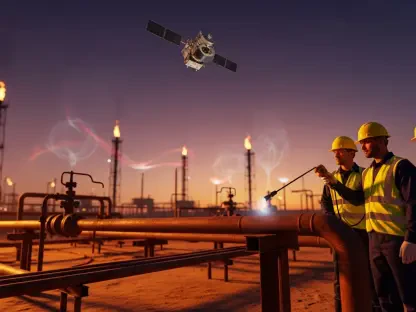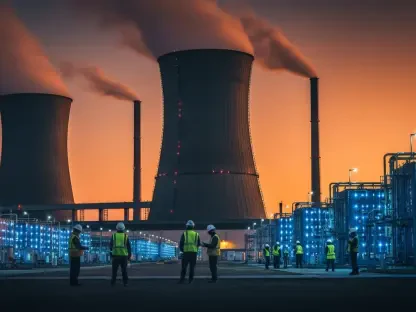Charting New Depths in India’s Energy Sector
India’s energy market stands at a critical juncture, grappling with an import dependency that sees nearly 80% of its crude oil and 50% of its natural gas sourced from abroad, highlighting a pressing need for domestic production. This staggering reliance, particularly in the untapped offshore basins that hold immense hydrocarbon potential, underscores the urgency for innovative solutions. Amid this backdrop, a transformative partnership between Oil India Limited (OIL) and TotalEnergies, formalized through a Technology Service Agreement in New Delhi, emerges as a game-changer for the deepwater exploration segment. This alliance promises to reshape market dynamics by leveraging global expertise to unlock frontier reserves.
The purpose of this market analysis is to dissect the implications of this strategic collaboration for India’s offshore energy sector. By examining current trends, technical advancements, and future projections, the focus is on how this partnership could catalyze growth in a high-stakes industry. The significance lies not just in immediate project outcomes but in the broader potential to reduce import burdens and enhance energy security. This exploration into deepwater and ultra-deepwater territories signals a pivotal shift, positioning India as a notable player in the global offshore market.
Market Trends and Projections in Offshore Exploration
Rising Focus on Deepwater Assets
The global energy market has increasingly tilted toward deepwater exploration as shallow reserves diminish, and India is aligning with this trend through aggressive offshore initiatives. Sedimentary basins along the country’s coastline, including Andaman, Mahanadi, and Krishna-Godavari, are drawing attention for their substantial untapped resources. However, the technical complexities and financial risks of drilling at depths beyond 1,500 meters have historically deterred rapid progress. The partnership between OIL and TotalEnergies marks a turning point, bringing in advanced seismic imaging and drilling technologies to navigate these challenges.
Current data suggests a growing investment in India’s offshore sector, spurred by policies like the Open Acreage Licensing Policy (OALP). Rounds such as OALP-IX and the ongoing OALP-X have opened ultra-deepwater blocks for bidding, attracting both domestic and international players. The involvement of a global leader like TotalEnergies, with a proven track record in regions like Guyana’s Stabroek Block, enhances market confidence. Projections indicate that successful discoveries in these basins could contribute significantly to domestic production within the next decade, potentially reducing import dependency by a notable margin.
A key trend to watch is the shift toward collaborative models in high-risk environments. The agreement’s focus on appraising gas discoveries in the Andaman Basin and exploring Category-II and Category-III basins reflects a strategic blend of immediate gains and long-term potential. Market analysts anticipate that such partnerships could set a precedent, encouraging more international firms to enter India’s offshore space, thereby driving competition and innovation. This evolving landscape points to a robust growth trajectory for the sector, contingent on sustained policy support and technological integration.
Technological Advancements Fueling Market Expansion
Technology stands as a cornerstone of the deepwater exploration market, with innovations directly impacting cost efficiency and success rates. TotalEnergies brings to the table cutting-edge methodologies, including AI-driven seismic analysis and remotely operated underwater systems, which are poised to revolutionize OIL’s operational capabilities. These tools are critical in mitigating the geological uncertainties and extreme conditions encountered in ultra-deepwater zones, where costs per well can soar into hundreds of millions of dollars.
Market forecasts highlight a surge in demand for such advanced solutions as exploration moves into frontier areas. The collaboration’s emphasis on stratigraphic well drilling in less-explored basins underscores a proactive approach to data acquisition, essential for accurate reserve estimation. Industry insights suggest that the adoption of these technologies could reduce exploration risks by up to 20% over the next few years, making previously unviable projects more attractive to investors. This technological edge is expected to bolster India’s position in the global offshore market, drawing parallels with successful regions like Brazil’s pre-salt fields.
Beyond immediate applications, the partnership signals a broader market shift toward digitalization in energy exploration. The integration of real-time data analytics and predictive modeling is likely to become standard, offering a competitive advantage to early adopters. As these tools become more accessible, smaller players in the Indian market may also benefit, potentially diversifying the sector. This trend of tech-driven exploration is set to redefine investment patterns, with a projected increase in capital allocation to deepwater projects through 2027.
Regional Opportunities and Market Challenges
Regional dynamics play a pivotal role in shaping India’s offshore exploration market, with basins like Andaman emerging as hotspots due to their vast potential. Government officials have drawn comparisons to Guyana’s transformative oil boom, highlighting the possibility of a similar breakthrough in this remote region. However, unique geological profiles and logistical hurdles demand tailored strategies, distinguishing Andaman from other areas like Mahanadi. TotalEnergies’ global experience in diverse offshore environments adds a layer of assurance to these endeavors.
Despite the optimism, market challenges persist, including high capital expenditure and long lead times from discovery to production—often spanning a decade or more. Fluctuating oil prices and the global transition to renewable energy further complicate investment decisions, creating uncertainty for stakeholders. Analysts project that while deepwater projects could yield significant returns, a balanced approach to risk management and cost-sharing will be essential. The partnership’s structure offers a model for addressing these issues, potentially influencing future agreements in the sector.
Another critical factor is regulatory evolution, with India’s Hydrocarbon Exploration and Licensing Policy expected to streamline approvals and incentivize exploration. Market growth hinges on such enablers, as they reduce bureaucratic delays and enhance investor appeal. The combined effect of regional potential and policy reforms could position India’s eastern offshore basins as key contributors to national energy output by the end of this decade, provided current momentum is sustained. This intricate balance of opportunity and obstacle defines the current market narrative.
Reflecting on Market Impacts and Strategic Pathways
Looking back, the alliance between Oil India and TotalEnergies carved a significant path in India’s offshore energy market, addressing critical gaps in technical expertise and capacity. It spotlighted the untapped potential of frontier basins while navigating the inherent risks of deepwater exploration. The collaboration’s dual focus on immediate projects and long-term opportunities through OALP rounds offered a blueprint for balancing ambition with pragmatism.
For industry stakeholders, several actionable steps emerged from this analysis. Prioritizing investments in advanced exploration technologies proved vital to minimizing risks and enhancing efficiency. Additionally, fostering similar international partnerships was seen as a way to accelerate market growth and build domestic capabilities. Finally, advocating for continued policy reforms to simplify licensing and incentivize exploration became a key recommendation to sustain investor interest.
Beyond these measures, a broader consideration was the need to align deepwater initiatives with India’s evolving energy mix, ensuring hydrocarbons complemented renewable goals. This partnership laid the groundwork for such integration, demonstrating how strategic collaborations could bridge immediate energy needs with future sustainability targets. As the market continued to evolve, these insights provided a roadmap for navigating the complex yet promising terrain of offshore exploration.









